In today’s digital landscape, where competition is fierce and attention spans are fleeting, a well-executed Google Ads strategy can be the game-changer for businesses seeking to drive targeted traffic, increase brand visibility, and achieve their marketing goals. As we step into the dynamic year of 2024, understanding and harnessing the power of Google Ads has never been more crucial.
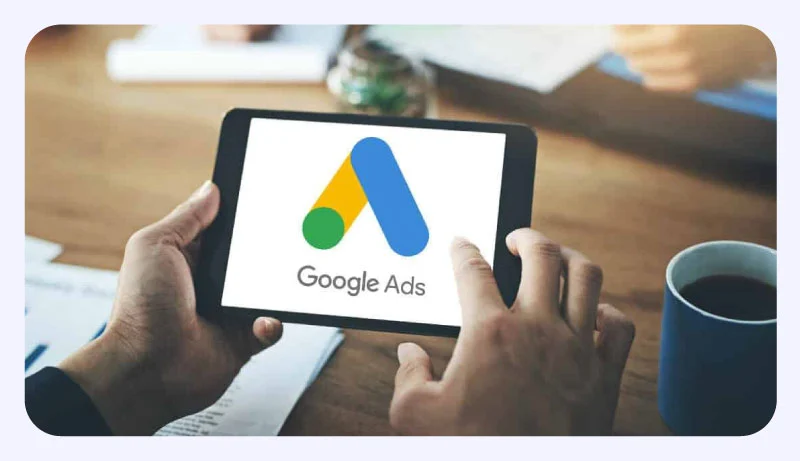
In this article, we will delve into the key elements of a successful Google Ads strategy in 2024, equipping you with the knowledge and insights necessary to optimize your campaigns and stay ahead in the ever-evolving realm of online advertising. So, let’s embark on this journey together, unraveling the secrets of a winning Google Ads strategy designed to propel your business to new heights of growth and profitability.
Understanding Google Ads
Welcome to the fascinating world of Google Ads, where the possibilities for reaching your target audience and achieving your business goals are endless. Picture this: a bustling digital marketplace where your brand can shine, grabbing the attention of potential customers at the right moment and in the right place. That’s the power of Google Ads.
Imagine having the ability to strategically position your ads across various digital channels, ensuring that your message reaches the right people at precisely the right time. With Google Ads, you can do just that. This powerful online advertising platform offers a treasure trove of opportunities to connect with your audience, whether they’re searching for specific products, watching videos, browsing websites, or even using mobile apps.
Google Ads is like an orchestra, with its key components working together in harmony to create a symphony of marketing success. You have ad campaigns, carefully crafted to target specific audiences and achieve specific objectives. Within each campaign, you have ad groups, allowing you to organize and fine-tune your messaging for different segments of your audience.
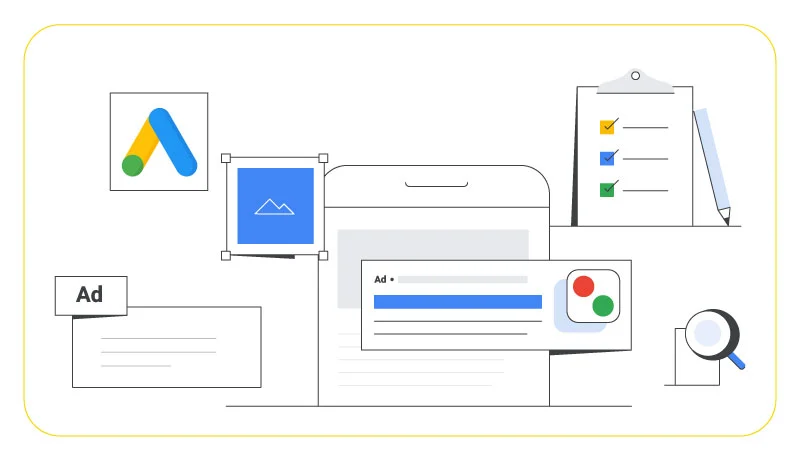
But the real magic lies in the keywords. These are the secret ingredients that unlock the doors to your brand’s online visibility. By choosing the right keywords, you can ensure that your ads appear when potential customers are actively searching for products or services related to your business. It’s like having a seat at the table when someone says, “I’m looking for exactly what you offer!”
Google Ads offers an array of campaign types, each with its own unique superpowers. You have Search Ads, where your ads appear prominently on the search engine results page, capturing the attention of users actively seeking information or solutions. Display Ads allow you to showcase your brand creatively on relevant websites and apps, reaching potential customers as they browse their favorite online destinations.
Related article: Pros and Cons of Google Ads
Videos are all the rage, and with Video Ads, you can tell your brand’s story through engaging and captivating visual content on platforms like YouTube. If you’re in the business of selling products, Google Shopping Ads put your products front and center, making it easier for shoppers to discover and purchase what you have to offer. And let’s not forget App Ads, designed to promote your mobile app and attract valuable users.
But it’s not just about getting your ads out there; it’s about getting results. Google Ads provides a wealth of data and insights, allowing you to measure the impact of your campaigns. You can track clicks, impressions, conversions, and more, enabling you to refine your strategies and optimize your return on investment.
Knowing Your Audiences
To maximize the effectiveness of your Google Ads strategy in 2024, it is crucial to have a deep understanding of your target audience. By identifying their needs, preferences, and behaviors, you can tailor your campaigns to resonate with them effectively. Here are the key steps to understanding and researching your target audience:
- Identifying Your Advertising Goals and KPIs: Before diving into audience analysis, clearly define your advertising goals and key performance indicators (KPIs). Are you aiming to drive sales, increase brand awareness, or generate leads? Setting specific and measurable goals will provide a framework for your Google Ads strategy.
- Conducting Market Research: Gain valuable insights into your industry, competitors, and market trends through comprehensive market research. Understand the challenges and opportunities within your niche, and identify gaps that you can leverage to differentiate your brand. Stay updated on industry trends, consumer preferences, and emerging technologies that can influence your audience’s behavior.
- Audience Analysis: Segment your target audience based on demographics, interests, and behavior. Develop buyer personas that represent your ideal customers, including their age, gender, location, profession, interests, and pain points. Conduct surveys, interviews, and focus groups to gather qualitative data and gain deeper insights into their motivations, needs, and purchasing behavior.

- Understanding Search Intent: Recognize the search intent behind your audience’s queries. Are they looking for information, products, or solutions? By understanding their search intent, you can align your Google Ads campaigns with their specific needs. Analyze search trends, popular search queries, and long-tail keywords to uncover the most relevant and valuable opportunities to engage your target audience.
- Leveraging Audience Tools and Analytics: Leverage the power of audience tools and analytics provided by Google Ads to gain valuable insights. Utilize tools like Google Analytics, Audience Insights, and Google Trends to understand your audience’s online behavior, interests, and preferences. These tools can help you refine your targeting, identify new audience segments, and make data-driven decisions to optimize your campaigns.
- Testing and Refining: As you gather data and insights about your target audience, continuously test and refine your campaigns. Experiment with different ad messaging, visuals, and offers to see which resonates most effectively. A/B testing can help you identify the best-performing ads and landing pages, allowing you to refine your strategy based on actual user response.
By understanding and researching your target audience, you can create compelling and targeted Google Ads campaigns that capture their attention, address their needs, and drive meaningful engagement. Remember, your audience is at the core of your strategy, and by aligning your messaging and offers with their preferences, you can achieve better results and maximize the impact of your Google Ads campaigns in 2024.
Keyword Research and Compelling Ad Copy
Strategic keyword research and compelling ad copy are vital components of a successful Google Ads strategy. Here are the key points you should consider:
- Keyword Research: Conduct thorough keyword research using tools like Google Keyword Planner. Identify high-value keywords relevant to your business and target audience. Focus on keywords with significant search volume and relevance to maximize your reach.
- Compelling Ad Copy: Craft persuasive ad headlines and descriptions that captivate your audience. Highlight unique selling points and incorporate a strong call-to-action (CTA) to encourage clicks. A/B test different ad variations to optimize performance and refine your messaging.
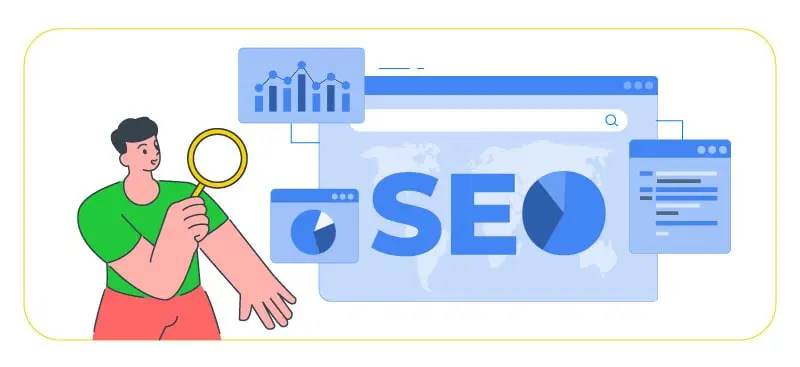
Strategic keyword research and compelling ad copy form the foundation of your Google Ads campaigns. By selecting the right keywords and creating captivating ad copy, you can enhance your visibility, attract qualified traffic, and drive better results.
Optimizing Landing Pages and Conversion Tracking
When it comes to Google Ads, driving traffic to your website is only half the battle. The true measure of success lies in converting those visitors into customers. That’s where landing page optimization and conversion tracking come into play.
- Designing for Conversion: Your landing pages should be designed with the sole purpose of encouraging visitors to take a specific action, such as making a purchase or filling out a contact form. Ensure that your landing page design is clean, visually appealing, and aligned with your brand identity. Use persuasive and benefit-driven copy to highlight the value proposition of your offering.
- Alignment with Ad Messaging and Keywords: Consistency is key. Your landing page should directly align with the messaging and keywords used in your Google Ads. When visitors arrive at your landing page, they should see a seamless transition from the ad they clicked on. Make sure the headline, imagery, and copy on your landing page clearly convey the same message and offer as your ad.
- Clear and Compelling Call-to-Action (CTA): Your landing page should feature a prominent and compelling call-to-action that directs visitors to take the desired action. Use action-oriented language and make the CTA button stand out visually. Experiment with different wording, colors, and placement to optimize its effectiveness.

- Implementing Conversion Tracking: Conversion tracking allows you to measure the success of your Google Ads campaigns by tracking specific actions taken by visitors on your website. Set up conversion tracking codes provided by Google Ads on relevant pages, such as the thank you page after a purchase or the confirmation page after form submission. This enables you to monitor and analyze conversion data to understand campaign effectiveness and make data-driven optimizations.
- Testing and Optimization: Continuously test different elements of your landing pages to identify what resonates best with your audience. Experiment with different layouts, headlines, visuals, and CTAs. A/B testing can provide valuable insights into what drives better conversion rates. Analyze the data and make informed decisions to optimize your landing pages for higher conversions.
By optimizing your landing pages and implementing conversion tracking, you can ensure that your Google Ads campaigns not only drive traffic but also lead to meaningful actions by your visitors. Remember to design your landing pages for conversion, align them with your ad messaging, use compelling CTAs, and track conversions effectively. Through continuous testing and optimization, you can improve your campaign’s performance and achieve better results.
Budgeting, Bid Management, and Continuous Optimization
Effective budgeting and bid management are critical aspects of a successful Google Ads strategy. Here’s engaging content to help you allocate your budget effectively and optimize your bids for maximum results:
- Determining Your Google Ads Budget: Allocating an appropriate budget is essential to ensure your ads reach the right audience and generate meaningful results. Consider your business goals, competition, and the average cost-per-click (CPC) in your industry. Start with a realistic budget that allows for experimentation and adjustment as you gather data and refine your strategy.
- Allocating Budget Effectively: Divide your budget strategically across campaigns based on their performance and priorities. Allocate more budget to campaigns that drive higher conversions or have proven to be successful. Regularly review and adjust your budget allocation to capitalize on opportunities and optimize campaign performance.
- Implementing Bid Strategies: Bid management plays a crucial role in achieving optimal ad placement and cost-efficiency. Leverage bidding strategies provided by Google Ads, such as automated bidding, to maximize your return on investment. Experiment with different bidding options like manual bidding or target cost-per-acquisition (CPA) bidding to find the approach that aligns with your goals.
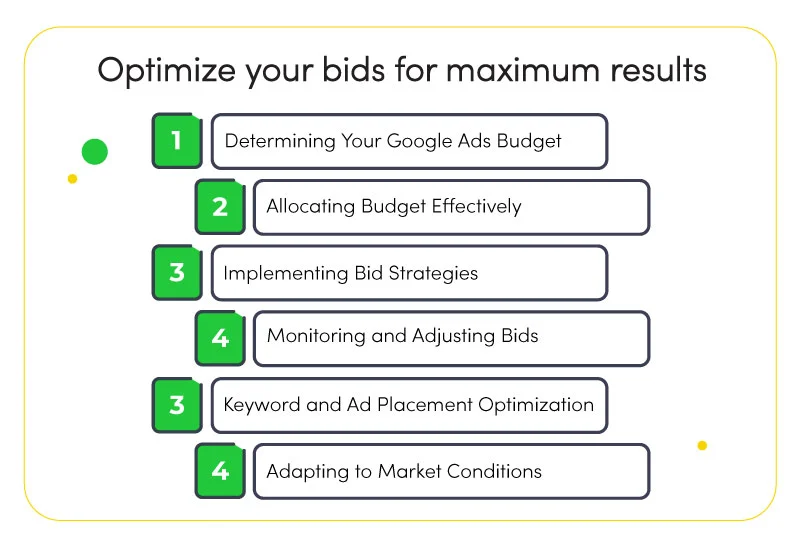
- Monitoring and Adjusting Bids: Continuously monitor your ad performance metrics, such as click-through rate (CTR), conversion rate, and cost-per-conversion. Identify underperforming keywords or campaigns and adjust your bids accordingly. Increase bids for high-performing keywords to maintain top ad positions and decrease bids for keywords with lower performance to improve cost-effectiveness.
- Keyword and Ad Placement Optimization: Regularly review your keyword performance and optimize your keyword list. Identify new high-value keywords based on search trends and user behavior. Explore ad placement options such as the Google Display Network or mobile advertising to expand your reach and capture a larger audience.
- Adapting to Market Conditions: Stay vigilant and adapt your bidding strategy to changes in the market and competition. Keep an eye on bid adjustments based on factors like device, location, and time of day to target specific segments more effectively. Monitor industry trends and adjust your bidding strategy accordingly to stay ahead of the curve.
By strategically allocating your budget, implementing effective bid strategies, and monitoring performance closely, you can optimize your Google Ads campaigns for maximum impact and cost-efficiency. Continuously refine your approach based on data-driven insights and adapt to market conditions to drive better results from your advertising investment.
Unlocking the full potential of Google Ads
Developing a comprehensive Google Ads strategy requires careful consideration of various advertising avenues. It involves crafting a well-defined Google display ads strategy, optimizing your approach to Google Shopping ads strategy development, and implementing an effective Google Display Network targeting strategy. By combining these three key elements, you can unlock the full potential of Google’s advertising platforms. Whether it’s leveraging visually captivating display ads to increase brand awareness and engagement, utilizing Google Shopping ads to showcase products and drive conversions, or harnessing the precise targeting capabilities of the Google Display Network to reach specific audiences, a holistic approach to these strategies ensures a comprehensive and impactful online advertising presence.
Conclusion
Crafting a well-defined and adaptive Google Ads strategy in 2024 is paramount to achieving success in the ever-evolving digital landscape. With the evolution of Google Adwords into Google Ads in 2021, it has become essential to stay updated with the latest features, trends, and best practices. By embracing the power of data-driven decision-making, conducting thorough keyword research, optimizing ad copy and landing pages, setting up conversion tracking, and continuously monitoring and refining campaigns, businesses can unlock the full potential of their advertising efforts. As the advertising landscape continues to evolve, embracing a comprehensive Google Ads strategy that leverages the capabilities of Google Ads and takes advantage of emerging trends will be crucial to driving impactful results and staying ahead of the competition in 2024 and beyond.
FAQs
What is a Google Ads strategy, and why is it important?
A Google Ads strategy refers to a comprehensive plan outlining how businesses will utilize Google Ads to achieve their advertising goals, targeting specific audiences, selecting appropriate keywords, and optimizing campaigns. It is important because it helps businesses reach their target audience, increase brand visibility, drive relevant traffic to their website, and ultimately achieve their desired marketing outcomes.
How do I determine the right advertising goals for my Google Ads strategy?
To determine the right advertising goals for your Google Ads strategy, start by identifying your overall business objectives. Consider whether you want to increase sales, generate leads, boost brand awareness, or drive website traffic. Set specific, measurable, attainable, relevant, and time-bound (SMART) goals that align with your business objectives, ensuring they are realistic and align with your available resources.
What are some key components to consider when crafting an effective Google Ads strategy?
When crafting an effective Google Ads strategy, key components to consider include thorough keyword research to identify high-value keywords, compelling ad copy that grabs attention and drives action, well-designed landing pages that align with the ad messaging, conversion tracking to measure campaign effectiveness, ongoing optimization through A/B testing, and monitoring key performance metrics such as impressions, clicks, conversion rate, and ROI.
How can I optimize my Google Ads campaigns to improve performance and maximize ROI?
To optimize your Google Ads campaigns, focus on several strategies. Continuously monitor and analyze campaign performance metrics to identify underperforming keywords or ads. Refine keyword targeting, adjust bidding strategies, and experiment with ad variations to improve click-through rates and conversion rates. Additionally, optimize landing pages to align with ad messaging, improve user experience, and drive higher conversion rates. Regularly review and refine your budget allocation and bid management strategies to maximize ROI and ensure cost-efficiency.
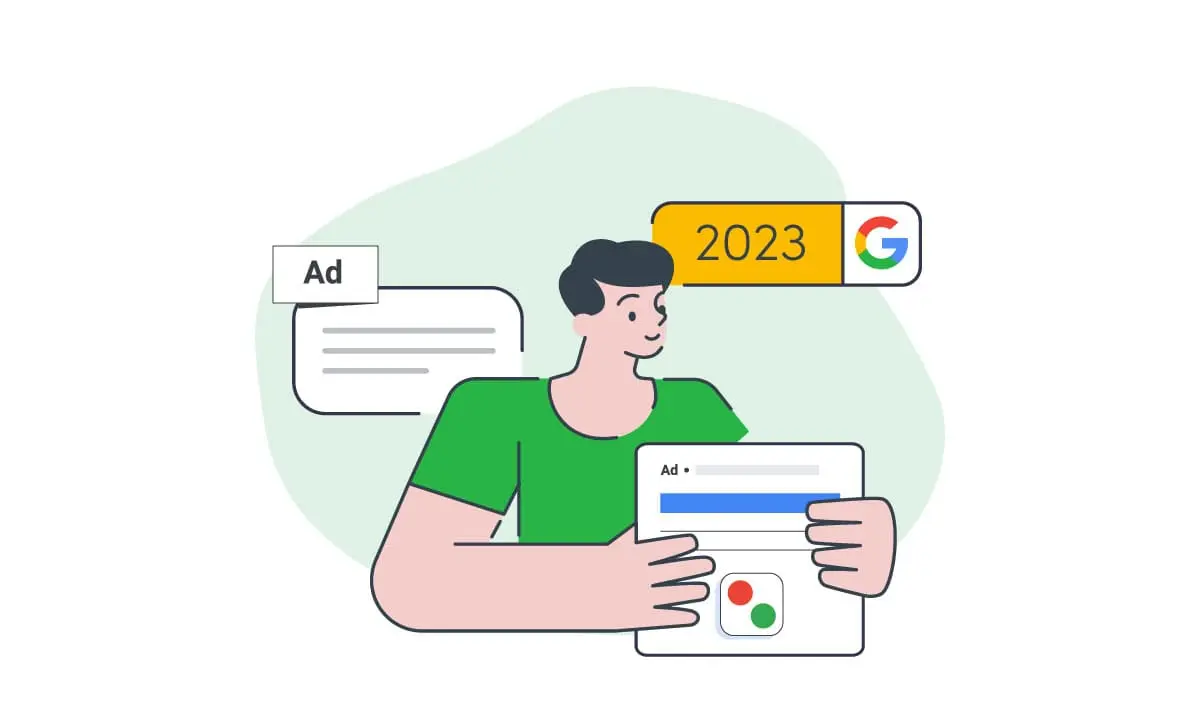
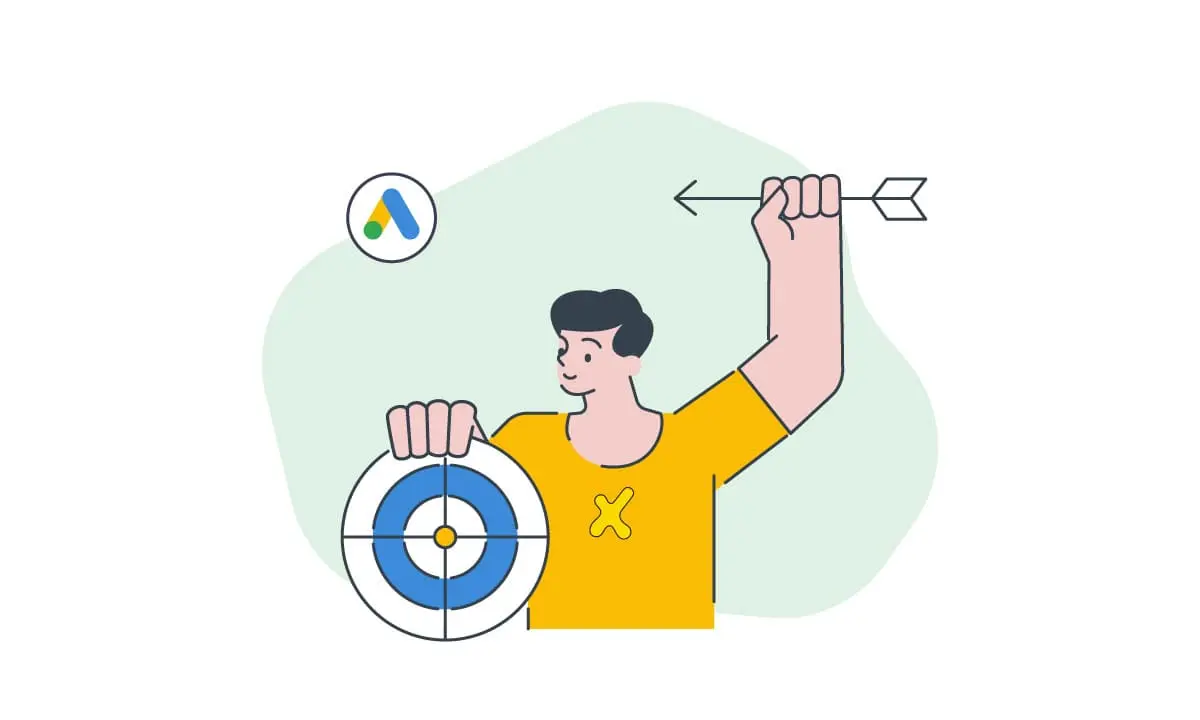
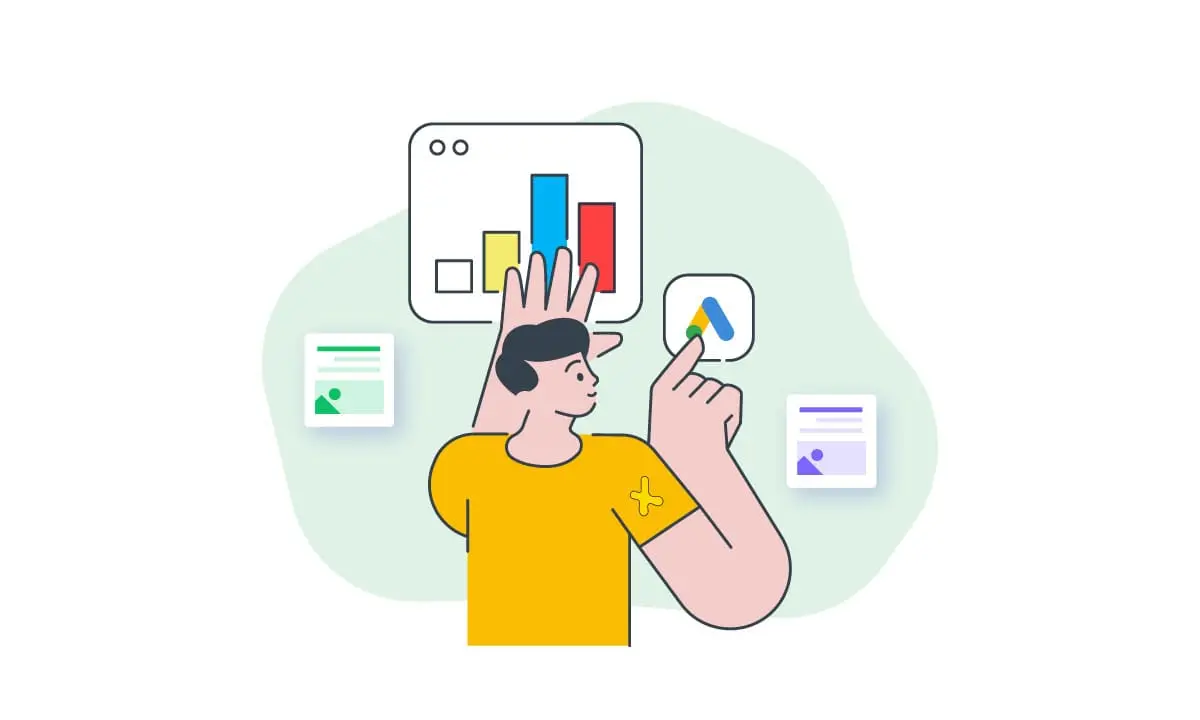




 Facebook Ads Spy Tool
Facebook Ads Spy Tool TikTok Ads Spy Tool
TikTok Ads Spy Tool